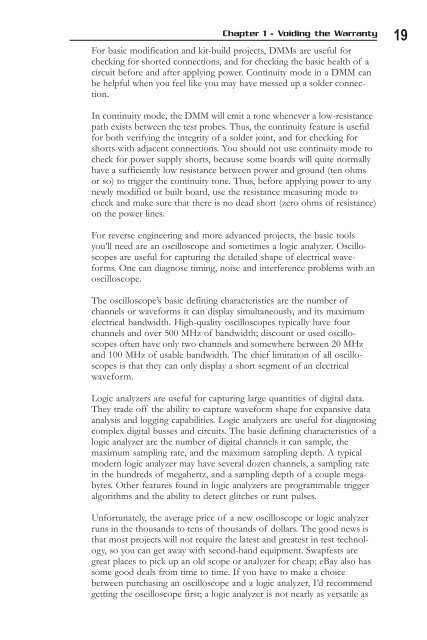Hacking the Xbox
Hacking the Xbox
Hacking the Xbox
Create successful ePaper yourself
Turn your PDF publications into a flip-book with our unique Google optimized e-Paper software.
Chapter 1 - Voiding <strong>the</strong> Warranty 19<br />
For basic modification and kit-build projects, DMMs are useful for<br />
checking for shorted connections, and for checking <strong>the</strong> basic health of a<br />
circuit before and after applying power. Continuity mode in a DMM can<br />
be helpful when you feel like you may have messed up a solder connection.<br />
In continuity mode, <strong>the</strong> DMM will emit a tone whenever a low-resistance<br />
path exists between <strong>the</strong> test probes. Thus, <strong>the</strong> continuity feature is useful<br />
for both verifying <strong>the</strong> integrity of a solder joint, and for checking for<br />
shorts with adjacent connections. You should not use continuity mode to<br />
check for power supply shorts, because some boards will quite normally<br />
have a sufficiently low resistance between power and ground (ten ohms<br />
or so) to trigger <strong>the</strong> continuity tone. Thus, before applying power to any<br />
newly modified or built board, use <strong>the</strong> resistance measuring mode to<br />
check and make sure that <strong>the</strong>re is no dead short (zero ohms of resistance)<br />
on <strong>the</strong> power lines.<br />
For reverse engineering and more advanced projects, <strong>the</strong> basic tools<br />
you’ll need are an oscilloscope and sometimes a logic analyzer. Oscilloscopes<br />
are useful for capturing <strong>the</strong> detailed shape of electrical waveforms.<br />
One can diagnose timing, noise and interference problems with an<br />
oscilloscope.<br />
The oscilloscope’s basic defining characteristics are <strong>the</strong> number of<br />
channels or waveforms it can display simultaneously, and its maximum<br />
electrical bandwidth. High-quality oscilloscopes typically have four<br />
channels and over 500 MHz of bandwidth; discount or used oscilloscopes<br />
often have only two channels and somewhere between 20 MHz<br />
and 100 MHz of usable bandwidth. The chief limitation of all oscilloscopes<br />
is that <strong>the</strong>y can only display a short segment of an electrical<br />
waveform.<br />
Logic analyzers are useful for capturing large quantities of digital data.<br />
They trade off <strong>the</strong> ability to capture waveform shape for expansive data<br />
analysis and logging capabilities. Logic analyzers are useful for diagnosing<br />
complex digital busses and circuits. The basic defining characteristics of a<br />
logic analyzer are <strong>the</strong> number of digital channels it can sample, <strong>the</strong><br />
maximum sampling rate, and <strong>the</strong> maximum sampling depth. A typical<br />
modern logic analyzer may have several dozen channels, a sampling rate<br />
in <strong>the</strong> hundreds of megahertz, and a sampling depth of a couple megabytes.<br />
O<strong>the</strong>r features found in logic analyzers are programmable trigger<br />
algorithms and <strong>the</strong> ability to detect glitches or runt pulses.<br />
Unfortunately, <strong>the</strong> average price of a new oscilloscope or logic analyzer<br />
runs in <strong>the</strong> thousands to tens of thousands of dollars. The good news is<br />
that most projects will not require <strong>the</strong> latest and greatest in test technology,<br />
so you can get away with second-hand equipment. Swapfests are<br />
great places to pick up an old scope or analyzer for cheap; eBay also has<br />
some good deals from time to time. If you have to make a choice<br />
between purchasing an oscilloscope and a logic analyzer, I’d recommend<br />
getting <strong>the</strong> oscilloscope first; a logic analyzer is not nearly as versatile as


